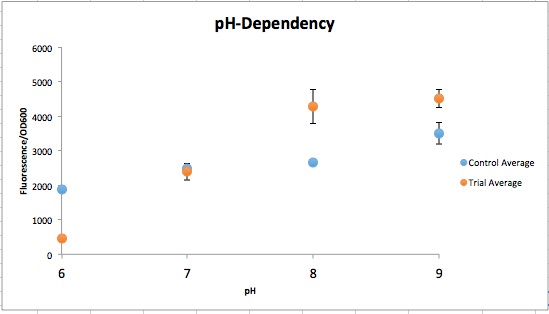AlexAlario (Talk | contribs) |
Gracetexana (Talk | contribs) |
||
| Line 6: | Line 6: | ||
<div class="column full_size"> | <div class="column full_size"> | ||
| + | <h1>Austin_UTexas</h1> | ||
| − | <h2 | + | <h2>Registry Parts</h2> |
| − | < | + | <h3>pH Sensors</h3> |
<p> | <p> | ||
| Line 29: | Line 30: | ||
<div class="column full_size" > | <div class="column full_size" > | ||
| − | < | + | <h3>Composite Parts</h3> |
</html> | </html> | ||
[[File:T--Austin_UTexas--BCPplate.png|thumb|left|600px| Figure 3. Control amilCP. This control was used to compare the color intensity to the pH sensitive P-atp2 while testing with a range of pH values. This part was documented to not be affected by changes in pH.]] | [[File:T--Austin_UTexas--BCPplate.png|thumb|left|600px| Figure 3. Control amilCP. This control was used to compare the color intensity to the pH sensitive P-atp2 while testing with a range of pH values. This part was documented to not be affected by changes in pH.]] | ||
Revision as of 21:25, 17 October 2016
Austin_UTexas
Registry Parts
pH Sensors
CpxA-CpxR
CpxA-CpxR is a two-component mechanism that is activated at pH 7.4 and repressed at pH 6.0. CpxA is an intermembrane protein that autophosphorylates at a certain external pH, CpxR (a kinase) then gets phosphorylated by CpxA and acts as a transcription factor. This system originally is a transcription factor for the virF gene, but we replaced virF with the Reporter. The original sequence was found in Shigella sonnei, but E. coli has a homolog of these proteins so all that is required on the construct is the appropriate prefix/suffix and CpxR binding site.

Figure 1 qualitatively depicts the Control at pH 6 with more expression of the Yellow-Green Chromoprotein than the Experimental at pH 6. The pH-Dependent promoter of the Experimental group is down-regulated at pH 6 whereas the control is not. Also, there is an increase in YGCP expression between the Experiment pH 7 and pH 8 that is not seen in the Control between pH 7 and pH 8. The normalized data in Figure 2 shows the relative expression of YGCP since the qualitative data is ambiguous. The construct can be found on the iGEM registry as: K2097001.
Composite Parts
Blue Chromoprotein
K2097001 is a composite part made up of BBa_K592009 (blue chromoprotein) and BBa_K608002 (a strong RBS and promoter). The protein exhibits a strong blue/purple color when expressed. BBa_K608002 is made up of a promoter, BBa_J23104, and an RBS, BBa_B003. LINKS
Yellow-Green Chromoprotein
K2097002 is a composite part made up of BBa_K1033916 (amajLime, a yellow-green chromoprotein)and BBa_K608006 (a medium promoter and RBS). LINKS



